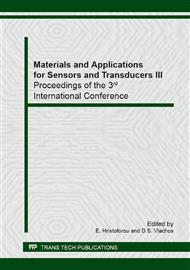p.185
p.189
p.194
p.198
p.202
p.207
p.211
p.215
p.219
Preparation and Selectivity of Resistive Acetone Gas Sensors Based on Polyaniline/Au Interdigitated Electrode
Abstract:
The acetone gas sensor can be applied in the fields of the occupational safety, the prevention of fire accident and explosion in plants and the diabetic patients breathe analysis. The properties of the sensing materials and the sensing characteristics of the acetone gas sensors based on polyaniline (PANI)/Au/porous ceramic plate prepared by the microfabrication technologies and the electrochemical methods are studied in this work. PANI with stable sensing performance is prepared by a three-stage chronopotentiometric method onto Au/porous ceramic plate. The PANI nanowires are uniformly distributed on Au interdigitated electrode surface characterized by field emission scanning electron microscopy (FESEM).The sensitivity and the response time of the resistive acetone gas sensor are obtained to be 4.0×10-3 % ppm-1 and 3 min when using N2 as carrier gas. Based on the same sensing electrode, the sensitivities of the gas sensor to mixed gas containing acetone are measured.Key words: gas sensor; acetone; polyaniline; sensitivity; selectivity
Info:
Periodical:
Pages:
202-206
Citation:
Online since:
April 2014
Authors:
Keywords:
Price:
Сopyright:
© 2014 Trans Tech Publications Ltd. All Rights Reserved
Share:
Citation:


